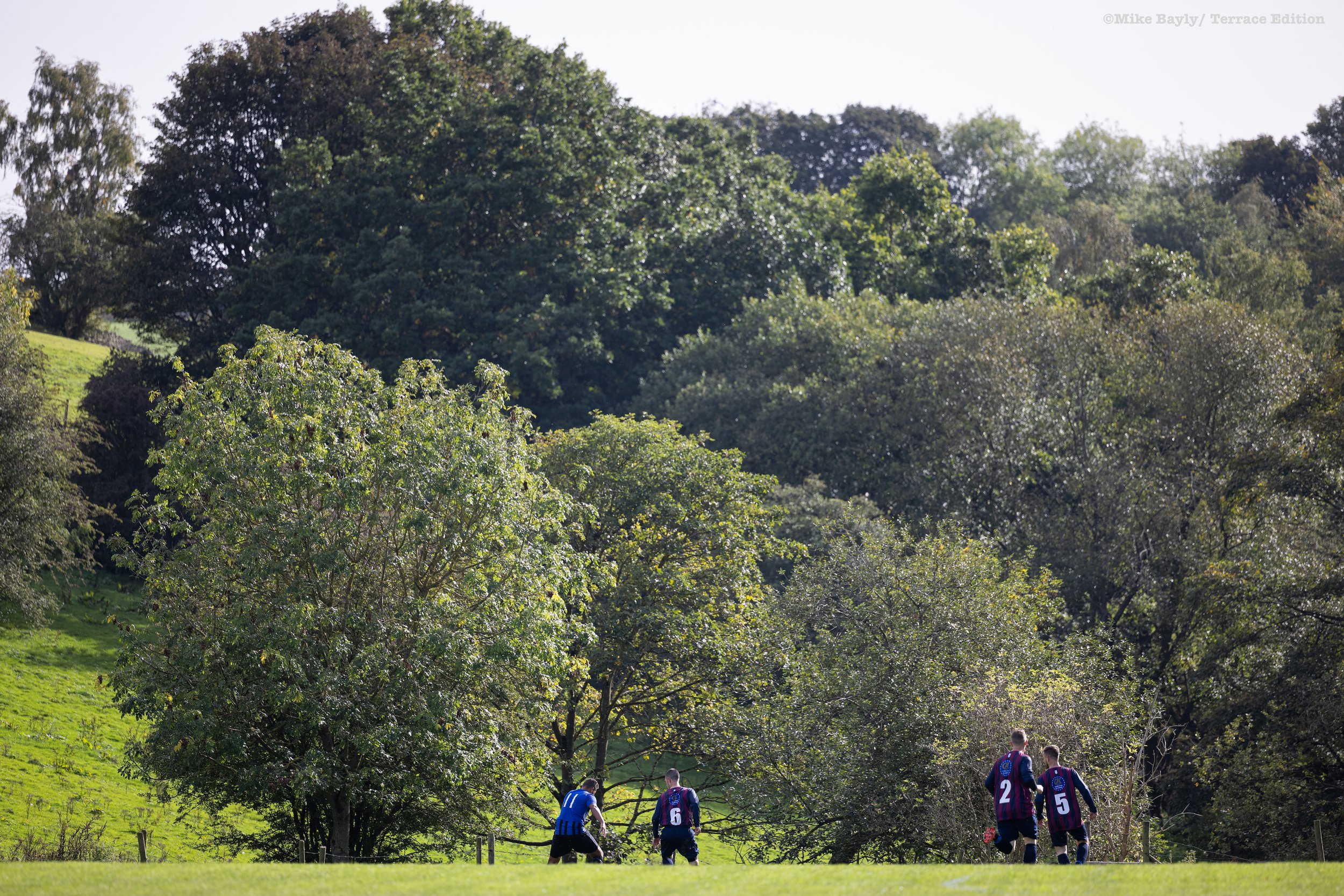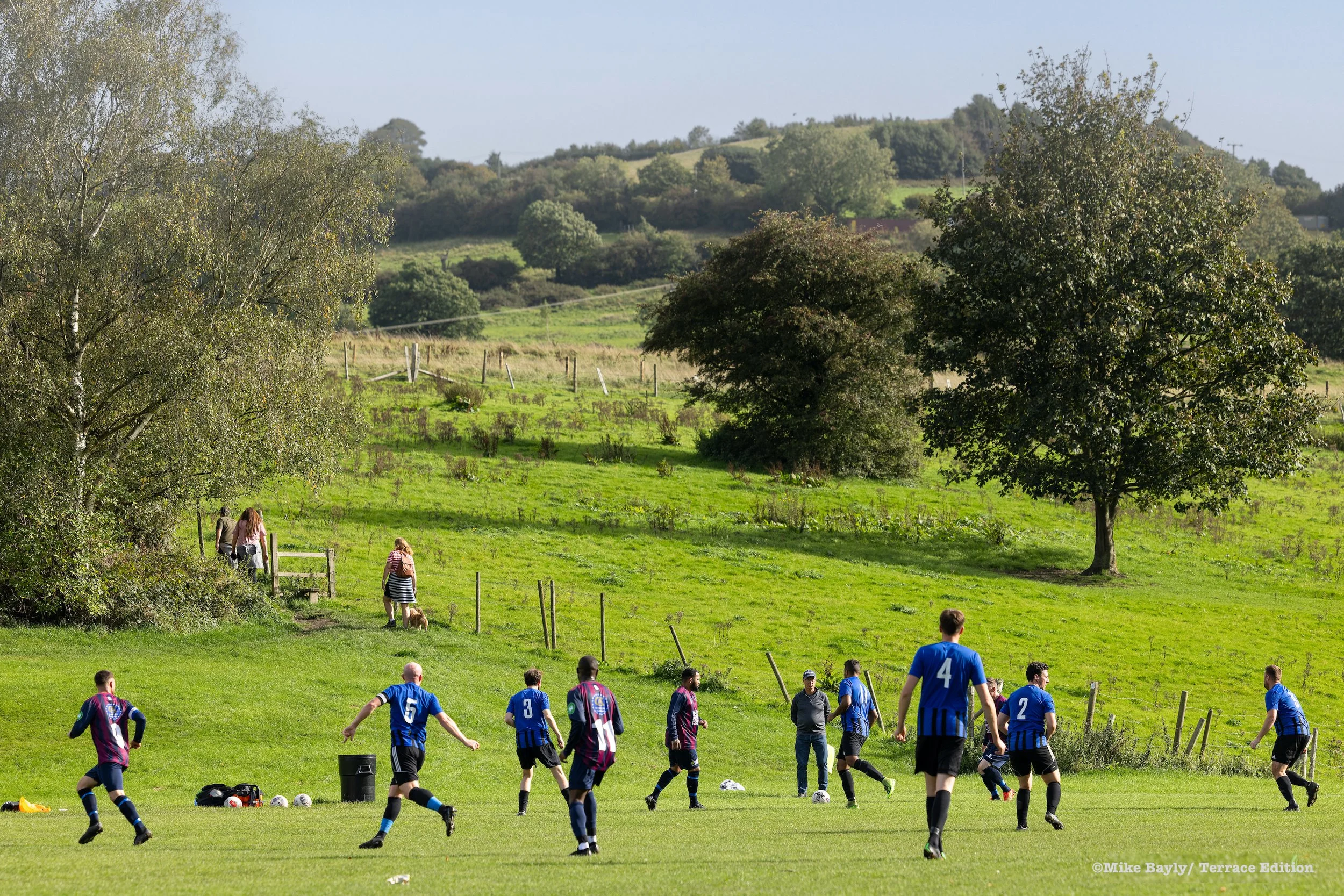Over the brow

Words: Mike Bayly
Images: Mike Bayly
In Michael Hardcastle’s 1973 book United!, amateur side Bank Vale United hold a whip round to purchase the talented but odious Nick Abel-Smith from a rival club for £1.
Abel-Smith eventually departs under a mutinous cloud, leaving his teammates to realise that friendship is more important than buying success. Regardless of this epiphany, I remember reading United! as a 10-year-old and being outraged at United’s absent Corinthian spirit.
As a fan weaned on non-League and park football, participation and a sense of belonging were more important than winning. Outspending competitors to win trophies seemed somehow meaningless. Or at the very least, undercut the achievement. It could be argued these were the principles of a naïve, idealistic juvenile, but I still hold them today.
Which is why, almost 40 years on, I continue to find solace in amateur football. While not immune from financial chicanery and structural issues, it is perhaps the last bastion of the sport in its purest, unpolluted form.
Clubs are operated on a voluntary basis, players generally participate without remuneration (indeed, many pay weekly subs to help running costs) and everyone involved does so solely for the love of the game. It is an intoxicating alternative to the sobering effect of elite football’s remorseless commodification.
©Mike Bayly/ Terrace Edition. Berry Brow AFC.
One of my favourite amateur competitions is the Huddersfield & District League (HDL). Formed in 1898, and historically featuring sides from Kirklees, Calderdale, Wakefield, Oldham and Rochdale, the HDL has approximately 70 members across its six divisions and is a mecca for scenic ground enthusiasts. The catchment area includes Holmfirth, the idyllic setting for BBC One’s Last of The Summer Wine.
My destination on Saturday was the village of Berry Brow, four miles north of Nora Batty country on the southern outskirts of Huddersfield, to visit the superbly named ‘Bernabrow’, home of Berry Brow AFC. No sitcom stardust here, but a football club that encapsulates the joys of the amateur game.
Football has been played in Berry Brow since at least the earliest 20th century. Early clubs included Berry Brow United and Berry Brown Wesleyans, playing in the HDL and Colne Valley League respectively.
An incident during Berry Brow v Millhouses in 1922 made national headlines when a Brow player in search of an alcoholic ‘restorative’, mistook a bottle of iodine for brandy and required urgent medical attention.
Berry Brow were re-established in 1963, having existed in various guises for over a century. While traditional Saturday football participation has contracted over the decades, Berry Brow run four adult teams, an incredible achievement in the current climate.
©Mike Bayly/ Terrace Edition. Berry Brow AFC.
Last season, the club collected an impressive five trophies, won promotion to the HDL Premier Division, and finished runners-up to Heywood Irish Centre in the Barlow Cup Final at Huddersfield Town’s stadium.
Based on the opening exchanges of the fixture against mid-table Shepley, Berry Brow’s success can be attributed to the style of play. I should qualify this statement. Despite watching football my entire life, the tactical side of the game baffles me. An informed coach sees zones, defensive transitions, overloads and gegenpressing. I see 22 players running around on a pitch.
However, even my layman understanding can recognise a well-drilled team that plays neat triangles and isn’t afraid to play the ball backwards or sideways if limited options are available.
At times, Berry Brow were a joy a watch. It wasn’t just the football that stood out. Amateur football grounds often occupy public parks, constrained by the land available. Sloping pitches are a common feature at this level, and the well-maintained Bernabrow is one of the few venues I’ve seen where it is possible to play downhill in both halves.
If football is the central character in these open spaces, activities off the pitch are the supporting cast: a young spectator negotiating a stile to retrieve wayward shots from the rough grass behind the far goal; dog walkers pausing momentarily to watch a free kick; a ballooned strike soaring over the park wall and crashing on to a car bonnet. You don’t get this minutia in the Premier League.
Maybe administrators are missing a trick: why not hold the infamous 39th game in a rugged rural setting? For all its perceived excitement, noting would beat the heart-in-mouth tension of a Nike Flight hurtling towards a row of Bentleys, or an international midfielder wading through a thicket of brambles with a corner flag to find a lost ball.
©Mike Bayly/ Terrace Edition. Berry Brow FC.
Berry Brow beat Shepley 7-2, a result that puts them top of the league. Nets are taken down, advertising hoardings packed away and boots cleaned. Among those tidying up is volunteer Neil Atkinson.
Atkinson started with the club as a player in 1980, later joining the committee. In addition to groundsman, he performs myriad other roles, which, in his own words include “anything that needs doing”. Today he even helped run the line. It isn’t hyperbolic to say amateur football wouldn’t exist without such people.
For those jaded by the perilous impact of modern football’s avarice, an outing to the countryside to watch an amateur game can be a cathartic experience. Hundreds of thousands of people play at or watch this level every week. It is the heartbeat of a national obsession. In November 1895, a syndicated newspaper article titled ‘A Defence of Association Football’ carried the line “If football cannot claim to be the national game, it can at least lay claim to be the people’s game.”
Almost 130 years on, I still believe football is the people’s game. You just need to know where to find it.
©Mike Bayly/ Terrace Edition. Berry Brow FC.
©Mike Bayly/ Terrace Edition. Berry Brow FC.
©Mike Bayly/ Terrace Edition. Berry Brow FC.
©Mike Bayly/ Terrace Edition. Berry Brow FC.
©Mike Bayly/ Terrace Edition. Berry Brow FC.
©Mike Bayly/ Terrace Edition. Berry Brow FC.
©Mike Bayly/ Terrace Edition. Berry Brow FC.
©Mike Bayly/ Terrace Edition. Berry Brow FC.
©Mike Bayly/ Terrace Edition. Berry Brow FC.
You can follow Mike on Twitter and Instagram: @Mike_Bayly

















